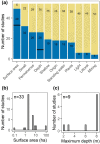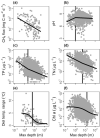A functional definition to distinguish ponds from lakes and wetlands
- PMID: 35729265
- PMCID: PMC9213426
- DOI: 10.1038/s41598-022-14569-0
A functional definition to distinguish ponds from lakes and wetlands
Abstract
Ponds are often identified by their small size and shallow depths, but the lack of a universal evidence-based definition hampers science and weakens legal protection. Here, we compile existing pond definitions, compare ecosystem metrics (e.g., metabolism, nutrient concentrations, and gas fluxes) among ponds, wetlands, and lakes, and propose an evidence-based pond definition. Compiled definitions often mentioned surface area and depth, but were largely qualitative and variable. Government legislation rarely defined ponds, despite commonly using the term. Ponds, as defined in published studies, varied in origin and hydroperiod and were often distinct from lakes and wetlands in water chemistry. We also compared how ecosystem metrics related to three variables often seen in waterbody definitions: waterbody size, maximum depth, and emergent vegetation cover. Most ecosystem metrics (e.g., water chemistry, gas fluxes, and metabolism) exhibited nonlinear relationships with these variables, with average threshold changes at 3.7 ± 1.8 ha (median: 1.5 ha) in surface area, 5.8 ± 2.5 m (median: 5.2 m) in depth, and 13.4 ± 6.3% (median: 8.2%) emergent vegetation cover. We use this evidence and prior definitions to define ponds as waterbodies that are small (< 5 ha), shallow (< 5 m), with < 30% emergent vegetation and we highlight areas for further study near these boundaries. This definition will inform the science, policy, and management of globally abundant and ecologically significant pond ecosystems.
© 2022. The Author(s).
Conflict of interest statement
The authors declare no competing interests.
Figures








References
-
- Alexander LC. Science at the boundaries: Scientific support for the Clean Water Rule. Freshw. Sci. 2015;34:1588–1594. doi: 10.1086/684076. - DOI
-
- Verpoorter C, Kutser T, Seekell DA, Tranvik LJ. A global inventory of lakes based on high-resolution satellite imagery. Geophys. Res. Lett. 2014;41:6396–6402. doi: 10.1002/2014GL060641. - DOI
-
- Holgerson MA, Raymond PA. Large contribution to inland water CO2 and CH4 emissions from very small ponds. Nat. Geosci. 2016;9:222–226. doi: 10.1038/ngeo2654. - DOI
-
- Dodds WK, Cole JJ. Expanding the concept of trophic state in aquatic ecosystems: It’s not just the autotrophs. Aquat. Sci. 2007;69:427–439. doi: 10.1007/s00027-007-0922-1. - DOI

